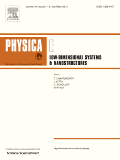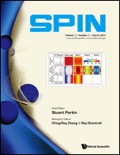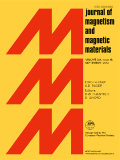
Journal of the Korean Magnetics Society
Scope & Guideline
Championing high-quality research in the world of magnetics.
Introduction
Aims and Scopes
- Magnetic Materials Research:
The journal emphasizes the study of various magnetic materials, including permanent magnets, soft magnets, and nanomaterials, investigating their properties, structures, and synthesis methods. - Spintronics and Quantum Magnetism:
Research on spintronics, which exploits the intrinsic spin of electrons for electronic devices, is a core area of focus. This includes investigating phenomena like spin currents, magnetic skyrmions, and quantum magnetism. - Magnetic Characterization Techniques:
The journal publishes studies that develop and apply advanced techniques for characterizing magnetic properties, including electron holography, ferromagnetic resonance, and Mossbauer spectroscopy. - Biomedical Applications of Magnetics:
An emerging theme is the application of magnetic technologies in biomedical fields, such as magnetic resonance imaging (MRI) and magnetic stimulation therapies. - Magnetic Device Engineering:
The journal covers design and optimization of magnetic devices, including motors, generators, and sensors, focusing on performance enhancement through innovative engineering practices.
Trending and Emerging
- Ultrafast Dynamics in Magnetics:
Research on ultrafast phenomena, including spin dynamics and THz emission, is gaining traction, highlighting the importance of time-resolved studies in understanding magnetic behavior. - Sustainable and Rare-earth Free Magnets:
There is a growing emphasis on developing sustainable magnetic materials that reduce reliance on rare-earth elements, addressing environmental concerns and supply chain issues. - Machine Learning in Magnetics:
The application of machine learning techniques to predict magnetization properties and optimize magnetic materials is an emerging theme, showcasing the intersection of data science and magnetics. - Advanced Biomedical Applications:
The journal is increasingly featuring research on advanced applications of magnetics in healthcare, particularly in MRI technology and magnetic nanoparticle therapies. - Spintronics for Neuromorphic Computing:
Research focusing on spintronics and its applications in neuromorphic devices is on the rise, reflecting the growing interest in brain-inspired computing technologies.
Declining or Waning
- Traditional Magnetic Materials:
There seems to be a waning interest in conventional magnetic materials studies, as researchers shift focus towards more innovative materials and applications, such as rare-earth-free alternatives. - Static Magnetic Field Applications:
Research focused solely on static magnetic field applications is declining, possibly due to the growing complexity and demand for dynamic and time-varying magnetic field applications. - Generalized Theoretical Models:
There is a noticeable reduction in publications centered around generalized theoretical models of magnetism, as the trend shifts towards experimental and application-based studies.
Similar Journals

Journal of Physics-Materials
Pioneering Research in Atomic and Molecular PhysicsJournal of Physics-Materials, published by IOP Publishing Ltd, serves as a leading platform for disseminating groundbreaking research in the realms of Atomic and Molecular Physics, Condensed Matter Physics, and Materials Science. This Open Access journal, established in 2018, enables wide-reaching visibility and accessibility to high-impact studies, fostering international collaboration and innovation within the scientific community. With a remarkable Q1 ranking in prestigious categories and impressive Scopus rankings—positioned at #38 in Condensed Matter Physics and #29 in Atomic and Molecular Physics—this journal plays a pivotal role in shaping contemporary research and discussions in physics and materials science. Researchers, students, and professionals alike are encouraged to contribute to and engage with the rich knowledge base this journal offers, which is dedicated to advancing the frontier of materials research and its numerous applications.

Magnetochemistry
Pioneering Research in MagnetochemistryMagnetochemistry is a premier academic journal dedicated to the study of magnetic phenomena in chemistry, published by MDPI, a globally recognized publisher known for its dedication to open science. Since its inception in 2015, this Open Access journal has provided a platform for researchers to share their findings and innovations in the fields of chemistry, particularly in the areas of electronic, optical, and magnetic materials. With a commendable impact factor and competitive ranking, including Q2 in miscellaneous chemistry and materials chemistry, and achieving notable placements within the Scopus ranks, Magnetochemistry stands out as a vital resource for professionals and students alike. By facilitating access to groundbreaking research, it significantly contributes to the advancement of the field, encouraging collaboration and further exploration among its diverse readership. Located in Switzerland, Magnetochemistry offers not only accessibility through its open access model but also a commitment to high-quality and impactful research outputs.

EUROPEAN PHYSICAL JOURNAL B
Bridging Theory and Application in Condensed Matter ScienceEUROPEAN PHYSICAL JOURNAL B (ISSN: 1434-6028, E-ISSN: 1434-6036), published by Springer, is a prominent international journal based in Germany that focuses on the fields of Condensed Matter Physics and Electronic, Optical and Magnetic Materials. With a converged publication timeline from 1998 to 2024, it caters to a diverse audience that includes researchers, professionals, and students striving for the latest advancements in these vital areas of physics. The journal is recognized with a Q3 ranking in both relevant categories for 2023, showcasing its solid yet notable standing within the academic community. Although currently without an H-index, its Scopus rankings reflect a percentile performance of 41st and 39th, respectively, indicating a growing influence among its peers. The journal offers open access options, ensuring that groundbreaking research is widely accessible and contributes to the collective knowledge within the scientific domain. By aiming to publish high-quality, well-researched articles, the EUROPEAN PHYSICAL JOURNAL B plays a crucial role in disseminating innovative findings and fostering collaboration in the field of physics.

PHYSICA E-LOW-DIMENSIONAL SYSTEMS & NANOSTRUCTURES
Unveiling the mysteries of materials at the nanoscale.PHYSICA E-LOW-DIMENSIONAL SYSTEMS & NANOSTRUCTURES, published by ELSEVIER, is a premier journal dedicated to advancing the field of condensed matter and nanoscience, focusing on the innovative properties and applications of low-dimensional systems. With an esteemed Q2 ranking in multiple categories including Atomic and Molecular Physics, Condensed Matter Physics, and Nanoscience for 2023, this journal serves as a vital platform for researchers and professionals aiming to disseminate and discuss cutting-edge research. Established in 1974 and converging its focus from 1997 onwards, PHYSICA E captures the evolving landscape of material science, making it a crucial resource for anyone invested in the dynamics of electronic, optical, and magnetic materials. Although the journal operates on a subscription basis, its broad accessibility and significant placement within Scopus rankings—such as being in the 83rd percentile for Condensed Matter Physics—underscore its importance within the academic community. Researchers and students alike will find this journal a cornerstone for fostering knowledge and collaboration in the fields of nanotechnology and low-dimensional physics.

SPIN
Innovating research in Electronic, Optical, and Magnetic Materials.SPIN, published by WORLD SCIENTIFIC PUBL CO PTE LTD, is a scholarly journal that serves as a vital resource for researchers, professionals, and students in the fields of Atomic and Molecular Physics, Electrical and Electronic Engineering, and Electronic, Optical, and Magnetic Materials. Established in 2011, this journal offers a platform for innovative research and significant advancements, contributing to the ongoing discourse in its specialized areas until 2024. Although classified under various quartile categories in 2023—Q4 in Atomic and Molecular Physics and Optics, Q3 in Electrical and Electronic Engineering, and Q4 in related Materials Science—the journal continues to strive for the highest scholarly standards and relevance. With Scopus rankings indicating its potential for growth, SPIN aims to foster knowledge dissemination and collaborative science addressing pivotal technological challenges. Located in Singapore, the journal also encourages submissions that showcase interdisciplinary approaches, thereby enhancing the global scientific community's understanding of current trends and future directions in these dynamic fields.

Nanosystems-Physics Chemistry Mathematics
Illuminating the Path of Interdisciplinary DiscoveryNanosystems-Physics Chemistry Mathematics is a prominent academic journal dedicated to advancing knowledge in the interdisciplinary fields of condensed matter physics, materials science, and mathematics. Published by the St. Petersburg National Research University of Information Technologies, Mechanics, and Optics, this journal plays a crucial role in disseminating valuable research findings and theoretical developments from 2019 to 2024. With an evolving scope that reflects the latest trends and methodologies, the journal strives to connect researchers, professionals, and students with groundbreaking discoveries and applications in nanotechnology and related areas. Although it currently holds a Q4 rating in Condensed Matter Physics and ranks within the Q3 tier in several categories, its commitment to promoting open dialogue and innovative solutions highlights its potential for growth and impact. Researchers can access various formats to ensure the accessibility of knowledge, further enriching the academic community's engagement with cutting-edge scientific developments.

JOURNAL OF MAGNETISM AND MAGNETIC MATERIALS
Driving Insights in Magnetism and MaterialsJOURNAL OF MAGNETISM AND MAGNETIC MATERIALS, published by Elsevier, stands at the forefront of research in the fields of magnetism and magnetic materials. With an established history since 1975 and a commitment to advancing knowledge through rigorous peer-reviewed studies, this journal has become a valuable resource for researchers and academics alike. Housed in the Netherlands and indexed under Scopus, it ranks Q2 in both Condensed Matter Physics and Electronic, Optical and Magnetic Materials, reflecting its impact within these domains. The journal aims to disseminate innovative research findings, methodologies, and reviews pertaining to magnetic phenomena, thus facilitating significant advancements in applications ranging from data storage technologies to medical imaging. While the journal does not feature open access options, it remains a vital part of the scientific dialogue, showcasing content that attracts a diverse audience, including researchers, professionals, and graduate students dedicated to enhancing their understanding of magnetism in various materials.

Journal of Magnetics
Illuminating the Pathways of Magnetic InnovationJournal of Magnetics, published by the Korean Magnetics Society, is an essential resource dedicated to advancing the knowledge and understanding of magnetics across the disciplines of Condensed Matter Physics, Electrical and Electronic Engineering, and Electronic, Optical and Magnetic Materials. With a focus on innovative research and development from 2008 to 2024, this journal serves as a platform for sharing cutting-edge findings and theoretical advancements in the field. Although it currently holds a Q4 ranking in established categories, it is an emerging publication that invites researchers, professionals, and students alike to contribute to and engage with its scientific discourse. Notably, it embraces a community of scholars aiming to bridge the gap between theory and practical applications in magnetics, despite its current Scopus rankings reflecting deeper industry competition. Based in South Korea, the journal operates from its office at Korea Sciences & Technology Center, RM 905, Yeoksam-dong 635-4, Kangnam-ku, Seoul 135-703, South Korea. While it does not provide open access, its commitment to academic rigor promises to elevate its stature in subsequent years, making it a vital publication for those keen on exploring the frontiers of magnetics.

Journal of the Korean Magnetic Resonance Society
Advancing Magnetic Resonance Research GloballyJournal of the Korean Magnetic Resonance Society, published by the Korean Magnetic Resonance Society, serves as a premier platform for advancing the field of magnetic resonance research. This journal, with the ISSN 1226-6531, is dedicated to disseminating innovative studies and critical reviews in areas encompassing magnetic resonance imaging, spectroscopy, and related technologies. Based in Seoul, South Korea, it aims to foster collaboration and knowledge exchange among researchers, professionals, and students globally. Although it follows a traditional subscription model, the journal is committed to high-quality, peer-reviewed content, ensuring that published articles undergo rigorous evaluation. By bridging the gap between academia and industry, the Journal of the Korean Magnetic Resonance Society plays a vital role in pushing the boundaries of magnetic resonance science, making it essential reading for anyone engaged in this cutting-edge field.

Progress in Superconductivity and Cryogenics
Innovating Tomorrow's Technologies Through SuperconductivityProgress in Superconductivity and Cryogenics is a distinguished academic journal published by the Korea Institute of Applied Superconductivity & Cryogenics, dedicated to advancing the field of superconductivity and cryogenic technologies. Since its inception in 2009, this journal has served as a pivotal platform for researchers and practitioners, promoting the dissemination of innovative findings and methodologies. Although currently positioned in Q4 quartiles in both Electrical and Electronic Engineering and Electronic, Optical and Magnetic Materials, the journal continually strives for excellence, offering insights that are essential for understanding the complexities of superconducting materials and their applications. While currently not an open-access journal, it provides invaluable research to the global scientific community. The journal's address is located in Changwon, South Korea, and aims to bridge the gap between theoretical research and practical implementation, making it a crucial resource for those engaged in the vibrant study of superconductivity.